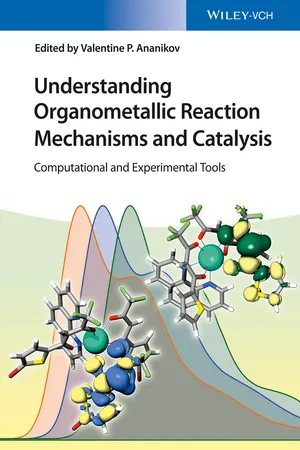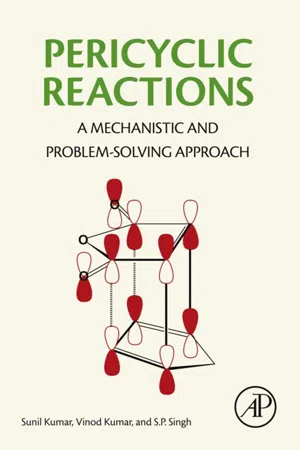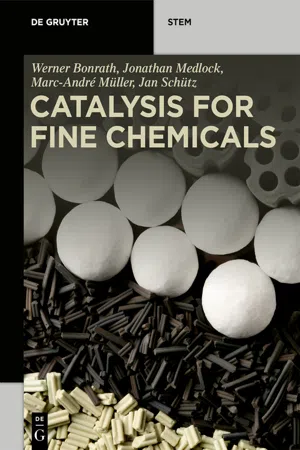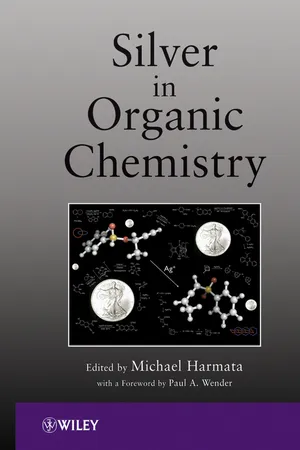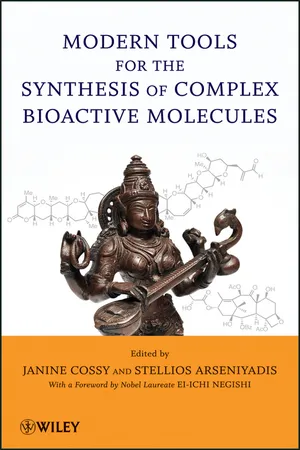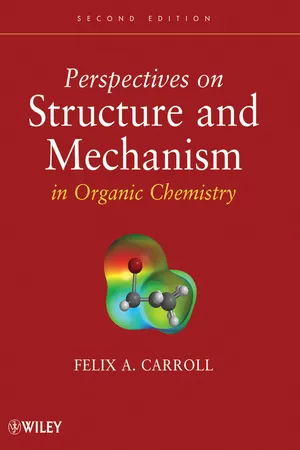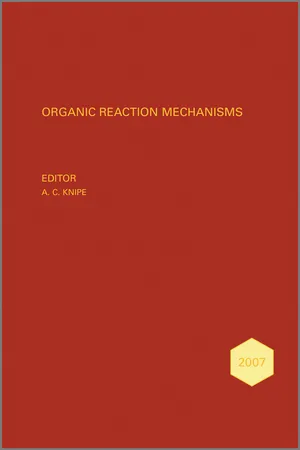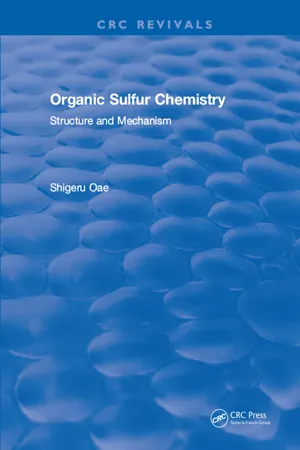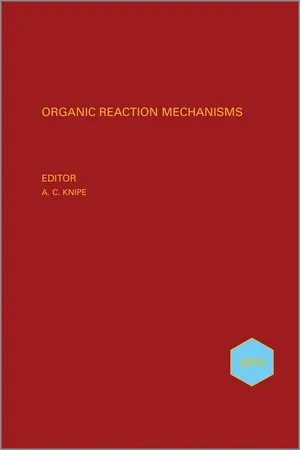Chemistry
Sigmatropic Rearrangement
Sigmatropic rearrangement is a type of organic reaction in which a sigma bond is rearranged within a molecule. It involves the movement of a substituent or a group of atoms from one part of the molecule to another, resulting in a new arrangement of the atoms. This reaction is often used in the synthesis of complex organic molecules.
Written by Perlego with AI-assistance
Related key terms
Related key terms
1 of 4
Related key terms
1 of 3
12 Key excerpts on "Sigmatropic Rearrangement"
- eBook - ePub
Understanding Organometallic Reaction Mechanisms and Catalysis
Computational and Experimental Tools
- Valentin P. Ananikov(Author)
- 2014(Publication Date)
- Wiley-VCH(Publisher)
Chapter 5 Computational Studies on Sigmatropic Rearrangements via π-Activation by Palladium and Gold CatalystsOsvaldo Gutierrez and Marisa C. Kozlowski5.1 Introduction
5.1.1 Sigmatropic Rearrangements
A sigmatropic shift or rearrangement is an intramolecular pericyclic reaction along a π-framework where one σ-bond is formed at the cost of breaking another σ-bond. When a fragment migrates, this transformation is typically referred to as a rearrangement . Canonical forms of the most frequent Sigmatropic Rearrangements are listed in Figure 5.1 , along with the standard naming convention. Heteroatom variants are common and virtually any center along the rearranging framework can be a heteroatom.Prototypical Sigmatropic Rearrangements.Figure 5.1Many Sigmatropic Rearrangements have been studied both experimentally and computationally [1]. Perhaps the most widely studied variant is the [3,3]-Sigmatropic Rearrangement, where X, Y, Z can be all carbons (Cope rearrangement) or various heteroatoms (Eq. (5.1 )). For example, Y = O and X, Z = C corresponds to the Claisen rearrangement. Many of these processes can occur thermally without catalysts, but catalysis via Lewis acid activation or π-activation has been demonstrated. Most of these rearrangements proceed via a concerted mechanism, but other radical and ionic pathways can intervene depending on the substitution and the presence of catalysts (Figure 5.2 ) [1].5.1Different possible mechanisms for the [3,3] Sigmatropic Rearrangement.Figure 5.25.1.2 Metal-Catalyzed Sigmatropic Rearrangements
Many metals catalyze Sigmatropic Rearrangements including several that likely function by π-activation such as mercury, palladium, platinum, and, most recently, gold. For the most part, computational studies have focused on understanding the mechanism and stereochemical-determining factors of [3,3]-sigmatropic shifts that do not involve π-activation [2]. Herein, we present a survey of those computational studies focusing on palladium- and gold-catalyzed sigmatropic shifts in which the transformation was promoted by π-activation, that is, complexation to either carbon-carbon double or triple bonds. - eBook - ePub
Pericyclic Reactions
A Mechanistic and Problem-Solving Approach
- Sunil Kumar, Vinod Kumar, S.P. Singh(Authors)
- 2015(Publication Date)
- Academic Press(Publisher)
3.4.4 Aza-Cope Rearrangement 1133.4.5 The Claisen Rearrangement 1153.4.6 Some Clever Variants of the Claisen Rearrangement 1293.5 [5,5] Sigmatropic Shift 1323.5.1 Solved Problems 1333.6 [2,3] Sigmatropic Rearrangements 1363.6.1 Solved Problems 1373.7 Peripatetic Cyclopropane Bridge: Walk Rearrangements 1393.7.1 Solved Problem 1413.8 Sigmatropic Rearrangements Involving Ionic Transition States 1423.8.1 Solved Problems 144Many thermal (or photochemical) rearrangements involve the shifting of a σ-bond, flanked by one or more π-electron systems, to a new position [i,j] within the molecule in an uncatalyzed intramolecular process. Since it is rearrangement of a σ-bond, these reactions are called Sigmatropic Rearrangements of order [i,j]. These reactions are often classified with two numbers, i and j, set in brackets [i,j] and the system is numbered by starting with the atoms forming the migrating σ-bond. These numbers [i and j] indicate the new positions of the σ-bond whose termini are i − 1 and j − 1 atoms removed from the original bonded loci (Scheme 3.1 ).Scheme 3.1 Sigmatropic Rearrangements of order [1,3] and [1,5].Very often, the migrating σ-bond is situated in between two π-bond systems as in the Cope and the Claisen rearrangements (Scheme 3.2 ).Scheme 3.2 Sigmatropic Rearrangements of order [3,3].3.1. Suprafacial and Antarafacial Processes
Since a sigmatropic reaction involves the migration of a σ-bond across the π-electron system, there are two different stereochemical courses by which the process may occur. When the migrating σ-bond moves across the same face of the conjugated system, it is called a suprafacial process whereas in antarafacial process the migrating σ-bond is reformed on the opposite π-electron face of the conjugated system . The following [1,5] sigmatropic shifts illustrate both these processes and their stereochemical consequences (Figure 3.1 - eBook - ePub
- Werner Bonrath, Jonathan Medlock, Marc-André Müller, Jan Schütz(Authors)
- 2021(Publication Date)
- De Gruyter(Publisher)
7 Rearrangement reactions7.1 Introduction
Rearrangement reactions are a broad class of organic reactions in which the reactant undergoes a rearrangement to give a structural isomer of the original molecule via a migration of an H atom or a larger molecular fragment. From the view of atom economy and E-factor, rearrangement reactions fulfil the criteria of the modern type of chemistry and green chemistry, with all atoms of the starting material being present in the product structure.In many rearrangement reactions, the migration occurs directly to a neighbouring position. These rearrangements belong to the class of [1,2]-rearrangements or [1,2]-shifts. These reactions are often Sigmatropic Rearrangements meaning that a σ-bond migrates during the reaction. The nomenclature of rearrangement reactions is described by numbering the atoms directly attached to the bond that is broken with 1 and 1ʹ (Scheme 7.1 ). The following atoms in the direction of the rearrangement are labelled 2, 3 and so forth starting from 1 and 2ʹ, 3ʹ and so forth starting from 1ʹ. After the rearrangement the new σ-bond is connected to two atoms which characterise the rearrangement. The numbers are listed in square brackets and the prime is removed from the second number.Scheme 7.1: Naming and examples of Sigmatropic Rearrangements.Some of the most important industrial rearrangement reactions, such as [3,3]-Sigmatropic Rearrangements, are used in the synthesis of isoprenoid building blocks such as isophytol, β-ionone or aroma compounds such as methyl heptanone. These are the main focus of this chapter.7.2 Wagner–Meerwein rearrangements
The Wagner–Meerwein rearrangement is a predominately acid-catalysed [1,2]-rearrangement in which a hydrogen, alkyl or aryl group migrates from one carbon to a neighbouring carbon to generate a new carbocation. This carbocation reacts with a nucleophile or a proton from a neighbouring atom is eliminated. The driving force of the reaction is that the initially formed carbocation has the tendency to rearrange to a thermodynamically more stable structure. In the terpene chemistry, the Wagner–Meerwein rearrangement is of importance in the manufacture of camphene from isoborneol (Scheme 7.2 - eBook - ePub
- Michael Harmata, Michael Harmata(Authors)
- 2011(Publication Date)
- Wiley(Publisher)
Chapter 3 Sigmatropic Rearrangements and Related Processes Promoted by Silver Jean-Marc Weibel, Aurélien Blanc, and Patrick Pale Laboratory for Organic Synthesis and Reactivity, Institute of Chemistry, University of Strasbourg, France 3.1 IntroductionSigmatropic shifts represent a large class of reactions involving the migration of at least one sigma bond. Therefore, such migrations lead to skeletal rearrangements of the carbon frame within the molecule undergoing this reaction.Sigmatropic Rearrangements usually involve σ bonds adjacent to a π system or a σ bond included in a strained system. As other transition metals, but with specific properties due to its d 10 electronic configuration, f orbitals and a relativistic effect,1 silver easily interacts with such systems. Silver salts have thus been explored as catalysts to facilitate and promote Sigmatropic Rearrangements.3.2 Wolff and Arndt–Eistert Rearrangements and Related ReactionsThe Wolff and Arndt–Eistert rearrangements are probably among the earliest known reactions promoted by silver ions.2, 3 Discovered at the turn of the nineteenth/twentieth century, the Wolff rearrangement allows the transformation of α-diazoketones to carboxylic acids,4 while the Arndt–Eistert rearrangement is a similar sequence also leading to carboxylic acids, but including the preparation of α-diazoketones from a shorter acid chloride (Scheme 3.1 ).5Scheme 3.1Numerous conditions have been developed for this transformation, but reproducible yields have usually been obtained by mixing a silver salt with a coreagent, such as silver nitrate associated with wet ammonia, silver oxide with triethylamine or sodium thiosulfate, and silver benzoate with triethylamine. Nonbasic conditions have also been described by Koch and Podlech using silver trifluoroacetate deposited on silica.6 - eBook - ePub
Comprehensive Enantioselective Organocatalysis
Catalysts, Reactions, and Applications, 3 Volume Set
- Peter I. Dalko, Peter I. Dalko(Authors)
- 2013(Publication Date)
- Wiley-VCH(Publisher)
40 Organocatalytic Sigmatropic Reactions Guillem Valero and Albert Moyano40.1 Introduction
Rearrangement reactions involving carbon-to-carbon or carbon-to-heteroatom migrations often provide unique paths for the rapid assembly of synthetically challenging organic molecules [1, 2]. In most instances, rearrangements are concerted processes, going through highly ordered cyclic transition states, so that these reactions take place with high levels of regio- and stereoselectivity, and not only the atomic connectivity but also the spatial atomic arrangement of the resulting products can be efficiently controlled. Although the study of molecular rearrangements dates back to the beginnings of organic chemistry in the nineteenth century, in the past two decades there has been an increasingly growing interest in stereocontrolled variants of Sigmatropic Rearrangements. As has happened with other synthetically useful methods such as cycloaddition or cyclization reactions, current investigations have led to the development of chiral catalysts that enable the use of rearrangements for the efficient preparation, in a diastereo-and enantioselective fashion, of biologically active natural products or of medicinally important chiral compounds. In comparison with the extensive use of asymmetric organocatalysis based on the aldol [3], Mannich [4], Diels-Alder [5], Michael reactions [6], and other chemical transformations [7], progress in the development of organocatalytically enantiocontrolled rearrangement reactions has been relatively slow. Thus, the first review devoted to the application of asymmetric organocatalysis to Sigmatropic Rearrangements was published in 2010 [8]. In this chapter we survey the most relevant instances of asymmetric organocatalytic sigmatropic reactions, covering the literature until the beginning of 2012. Note that in this chapter we will adopt the more general IUPAC definition of a sigmatropic reaction as a molecular rearrangement that involves both the creation of a new σ-bond between atoms previously not directly linked and the breaking of an existing σ-bond, so that we will deal with both concerted (pericyclic) and stepwise Sigmatropic Rearrangements. - Janine Cossy, Stellios Arseniyadis, Janine Cossy, Stellios Arseniyadis(Authors)
- 2012(Publication Date)
- Wiley(Publisher)
Chapter 8 Rearrangements in Natural Product Synthesis José Marco-Contelles and Elena Soriano Laboratorio de Química Médica y Computacional, Instituto de Química Orgánica General, Madrid, Spain8.1 Introduction
Molecular rearrangements occupy center stage in the development of organic synthesis [1] and have resulted in various impressive achievements that have been reported in the last decades [2]. Accordingly, the purpose of this chapter is to highlight the use of a set of selected molecular rearrangements and show how these reactions have been utilized as efficient regio-, enantio-, and chemoselective synthetic tools for the preparation of complex bioactives.Our selection has been mainly addressed to pericyclic reactions, among them the [3,3]-Sigmatropic Rearrangements [3], which continue to provide excellent opportunities for reaching high chemical diversity. In the class of the [3,3]-Sigmatropic Rearrangements, focus will be on the neutral [3,3]-sigmatropic Cope [4], oxy-Cope/anionic oxy-Cope [5], Claisen [4], and Overman [6] rearrangements, as well as the cationic [3,3]-sigmatropic Petasis–Ferrier [7] and Prins–pinacol [8] rearrangements, and the anionic [1,2]- and [2,3]-sigmatropic Wittig rearrangements [9]. Finally, and in order to complement the selected pericyclic reactions, we will end this chapter with some very well-known propargylic rearrangements, such as the Meyer–Schuster and Rupe rearrangements [10], which are very useful synthetic methods for the transformation of allylic alcohols into α,β-unsaturated carbonyl derivatives. It is worth pointing out that these rearrangements are among the most basic and useful transformations in synthetic organic chemistry. This is due to the fact that these rearrangements are efficient for controlling quaternary, sterically hindered chiral centers and for building carbon–carbon and carbon–heteroatom bonds in a stereoselective fashion. In addition, [3,3]-Sigmatropic Rearrangements can be easily integrated and adapted in cascade processes as simple methods to prepare complex molecules in atom-economical reactions.- No longer available |Learn more
- Felix A. Carroll(Author)
- 2011(Publication Date)
- Wiley(Publisher)
FIGURE 11.47 Allowed suprafacial–antarafacial transition structure for photochemical Cope rearrangement. Note the rotation about the lower portion of the structure.Further Examples of Sigmatropic ReactionsFIGURE 11.48Suprafacial–suprafacial transition structuresforthethermal (top) and photochemical (bottom) [3,5] sigmatropic reaction.The selection rules for sigmatropic reactions are powerful predictors of thermal rearrangements.8 They explain how some reactions can occur ster-eospecifically and with surprisingly low activation energies, while others do not. For example, cis-1,2-divinylcyclopropane (44) undergoes a [3,3] Sigmatropic Rearrangement to cis,cis-1, 4-cycloheptatriene (45) with a half-life of 25 min at 11 °C (Figure 11.49 ).65, 66 trans -1,2-Divinylcyclopropane (46) reacts to give the same product, but only upon heating to about 150°C.67 Apparently the reaction of 44 is fast because the cis geometry places the two double bonds in the proper relationship for the Cope rearrangement. In the trans isomer, however, the termini of the two double bonds cannot overlap. Therefore, the reaction of 46 may proceed by a nonconcerted process involving breaking the cyclopropane ring to form a biradical intermediate.68FIGURE 11.49Thermal rearrangements of cis- and trans -1,2-divinylcyclopropane.FIGURE 11.50Degenerate Sigmatropic Rearrangement of homotropilidene.Both 44 and 46 are higher in energy than 45. Sigmatropic Rearrangements can also result in degenerate rearrangements of structures such as homotropilidene (47, Figure 11.50 ).69 Perhaps the most dramatic example of a Sigmatropic Rearrangement is provided by tricyclo[3.3.2.04, 6 ]deca-2,7,9-triene (48, Figure 11.51 ), more commonly known by the trivial namebullvalene.70Although there are only ten carbon atoms in the molecule, the various permutations possible through [3,3] Sigmatropic Rearrangements produce about 1.2 million valence isomers.71, 72 The isomerization is so fast that the 1 H NMR spectrum is a broad peak at room temperature, and the spectrum sharpens to a single peak at 120°C. At –85°C, the isomerization slows to the point that separate peaks for vinyl, cyclopropyl, and methine protons can be seen (Figure 11.52 ). Analysis of the spectrum indicates that the valence isomerization occurs with a rate constant of 540 s–1 at 0°C and has an activation energy of 12.8kcal/mol.71,73,74 - eBook - ePub
Organic Reaction Mechanisms 2007
An annual survey covering the literature dated January to December 2007
- A. C. Knipe, A. C. Knipe(Authors)
- 2011(Publication Date)
- Wiley(Publisher)
CHAPTER 13 Molecular Rearrangements: Part 1. Pericyclic Reactions S. K. Armstrong Formerly of Department of Chemistry, University of Glasgow[3,3]-Sigmatropic RearrangementsAll-carbon Pericyclic Systems One Heteroatom Two or More Heteroatoms[2,3]-Sigmatropic RearrangementsOther [n,m]-Sigmatropic Rearrangements[1,n ]-Sigmatropic RearrangementsBergman and Related Diradical RearrangementsElectrocyclic RearrangementsGroup Transfer ReactionsTandem Pericyclic RearrangementsReferencesThe 2006 literature on mechanisms of pericyclic reactions1 and the beneficial effect of an aqueous environment for pericyclic reactions, including Sigmatropic Rearrangements, have been reviewed.2 Multicentre electron delocalization indices have been used to characterize the aromatic transition states of a range of pericyclic processes, including four- and six-electron electrocyclic ring closures and [3,3]-Sigmatropic Rearrangements. Advantages over magnetic characterization have been reported.3[3,3]-Sigmatropic Rearrangements All-carbon Pericyclic SystemsQuantum chemical calculations on unsubstituted semibullvalene have suggested that complexation to a halogen molecule (X2 or XY) can remove the energy barrier for Cope rearrangement, giving a fairly flat potential energy surface with a delocalized minimum. Complexation of semibullvalene to some simple Lewis acids, or of barbaralane to halogens, was predicted to reduce the energy barrier for the Cope rearrangement, but not to remove it completely: the minima found were not delocalized.4 Quantum chemical calculations on Pd(II)-promoted Cope rearrangements of 2-substituted hexa-1,5-diene have suggested that charge separation usually occurs in an intermediate with positive charge on C(2), but that the intermediate occupies a very shallow potential well even when a cation-stabilizing substituent is present. With an electron-withdrawing substituent such as 2-F3C- or 2-NC-hexa-1,5-diene, the rearrangement was found to be concerted even with Pd(II) promotion, with charge separation occuring in the Pd-bound transition state.5 - eBook - ePub
- Shigeru Oae(Author)
- 2018(Publication Date)
- CRC Press(Publisher)
Chapter 8 REARRANGEMENTS I. INTRODUCTIONRearrangement reactions are less common in organosulfur chemistry than in other areas of organic chemistry. Nevertheless, there are a few important rearrangements which include the Stevens, the Sommelet-Hauser, the Moffatt-Pfitzner, the Pummerer, and some Sigmatropic Rearrangements and which will be discussed in this chapter.II. THE STEVENS REARRANGEMENT1 ,2 ,3When sulfonium salts bearing an alkyl substituent on the sulfur atom are treated with alkali, an α-proton is removed affording sulfonium ylides (1), which undergo what appears to be [1,2]-Sigmatropic Rearrangement (Equation 1 ).4 A similar rearrangement takes place with ammonium salts.5 Although the rearrangement appears to follow the Woodward-Hoffman rule,6 it is by no means a concerted reaction. When the reaction was carried out with a sulfonium salt bearing an optically active R′ group, the stereochemical integrity of the migrating site was partially preserved. During the rearrangement, a chemically induced dynamic nuclear polarization (CIDNP) was observed,7 thus, the rearrangement via a radical-cage process (Equation 2 ) has been suggested.(1) (2) Extremely rapid radical recombination within the cage 2 makes possible the high degree of retention of configuration of the R′ group.Both Baldwin et al.8 and Schölkopf et al.9 believe that the rearrangement proceeds through two steps. In the following rearrangement, the PhRCH group migrated with 44% excess retention of configuration, clearly suggesting that the intermediate 3 undergoes cage recombination (Equation 3 ).8(3) Rearrangement of compound 4 gave by-products, such as 5 and 6,9 which result from homolytic cleavage of the S-C bond (Equation 4 ). The entropies of activation are + 19 e.u. in CDCl3 and +38 e.u. in benzene.10 Their very high values are also in keeping with the mechanism.(4) The products of a crossover experiment using two D-labeled sulfonium salts 7 and 8 are shown in Equation 5 . Thus, all evidence clearly refutes the one-step concerted mechanism suggested by Dewar and Ramsden.11 - eBook - ePub
Organic Reaction Mechanisms 2013
An annual survey covering the literature dated January to December 2013
- A. C. Knipe, A. C. Knipe(Authors)
- 2016(Publication Date)
- Wiley(Publisher)
Chapter 12 Molecular RearrangementsJ. M. CoxonDepartment of Chemistry, University of Canterbury, Christchurch, New Zealand- Pericyclic Reactions
- [3,3]-Sigmatropic, Claisen, Cope, and Thio Claisen
- Electrocyclization and Cyclo-Reversion
- 1,3-Dipolar Cycloaddition
- Sigmatropic Shift
- 2,3-Sigmatropic Shift
- Alder-ene Reaction
- Miscellaneous Pericyclic Reactions
- Molecular Rearrangements
- Acid- and Lewis-Acid-Catalysed Reactions
- Ring Opening, Closing, and Expansion Reactions
- Rearrangements
- 1,2-Migration
- Pinacol rearrangement
- Benzoin rearrangement
- Benzidine rearrangement
- Acyl migration
- Isomerization
- C–H insertion
- Reactions Involving Silicon, Sulfur, Phosphorus, and Halogen
- Thermal Reactions
- Oxidation and Oxidative Rearrangements
- Metathesis Reactions
- Metal-Induced Reactions
- Copper
- Gold
- Indium
- Iridium
- Manganese
- Palladium
- Platinum
- Rhodium
- Silver
- Named Reactions
- Beckmann rearrangement
- Boulton–Katritzky rearrangement
- Brook rearrangement
- Dimroth rearrangement
- Ferrier rearrangement
- Grignard reaction
- Horner–Wadsworth–Emmons reaction
- Kinugasa reaction
- eBook - ePub
Organic Reaction Mechanisms 2010
An annual survey covering the literature dated January to December 2010
- A. C. Knipe, A. C. Knipe(Authors)
- 2012(Publication Date)
- Wiley(Publisher)
Chapter 13 Molecular Rearrangements: Part 1. Pericyclic Reactions J. M. CoxonDepartment of Chemistry, University of Canterbury, Christchurch, New Zealand[3,3]-Sigmatropic, Claisen, and Cope Rearrangements [2,3]-Reactions Vinyl Cyclobutane and Vinyl Cyclopropane Rearrangement 1,2-Migration Ene Reaction Bergman Reaction Electrocyclic Reactions Cyclization 4 + 2-Cycloadditions 3 + 2-Cycloadditions Metathesis Metal-catalysed Reactions Miscellaneous References[3,3]-Sigmatropic, Claisen, and Cope Rearrangements
The diastereoselectivity of the [3,3]-rearrangement of 1,1-disubstituted allyl carboxylates (Scheme 1 ) has been reported to be a consequence of the transition state having a boat-like transition structure because of the participation of the lone pairs and the secondary orbital interaction.1 Although the transition structure for the [1,3]-rearrangement has a higher barrier, it is said not to proceed in the usual antarafacial manner due to the cyclic orbital interaction among two lone pairs of the carboxylate and the allylic lumo. The geminal bond participation controls the stereoselectivity in the [3,3]-rearrangement. The bond model analysis showed that electron-withdrawing σ-bond substituents prefer to occupy the Z - eBook - ePub
Electron Flow in Organic Chemistry
A Decision-Based Guide to Organic Mechanisms
- Paul H. Scudder(Author)
- 2023(Publication Date)
- Wiley(Publisher)
Sigma molecular orbitals pose a difficult representational problem, for they usually are as large and as complex as the framework of the molecule itself. Commonly we treat the sigma framework as if it were completely localized, chopping up the representational problem into intellectually convenient little pieces, each piece corresponding to a particular bond or electron pair. Toward this end, the atomic orbitals are mixed to give hybridized orbitals that are more convenient for the discussion of these localized bonding orbitals. These localized bonding orbitals are easy to use and correspond to the lines and dots of our Lewis formula. There are very few penalties for using hybrid orbitals and treating the sigma framework as localized, when it actually is not.13.7 CONCERTED PERICYCLIC CYCLOADDITION REACTIONS
13.7.1 Introduction to Pericyclic Reactions
Pericyclic reactions have cyclic transition states and electron flow paths that appear to go around in a loop. There are three main types of pericyclic reactions shown in Figure 13.37 : cycloaddition reactions, electrocyclic reactions, and Sigmatropic Rearrangements. Cycloaddition reactions form a ring from two pi systems coming together. Electrocyclic reactions close the ends of a single pi system to form a ring or the reverse, open a ring to form a single pi system. Sigmatropic Rearrangements move a sigma bond from one part of a pi system to another. The examples shown all have a transition state in which six electrons move around in a loop. The rules for prediction of the products will depend on many factors, including the number of electrons in the process.Examples of the three types of pericyclic reactions.Figure 13.3713.7.2 Cycloaddition Reactions
Four‐Electron (4n) Cycloaddition Reactions
Concerted four electron suprafacial–suprafacial cycloaddition reactions are not “thermally allowed.” All this really means is that the transition state for an allowed process is much lower in energy. Suprafacial just means on the same side or face of the molecule; antarafacial means on opposite faces. HOMO–LUMO theory explains why the concerted 2 + 2 cycloaddition of two ethylenes is not favored. Bonding overlap between a HOMO and a LUMO lowers the transition state energy of the allowed process, making it favorable. Figure 13.38
Index pages curate the most relevant extracts from our library of academic textbooks. They’ve been created using an in-house natural language model (NLM), each adding context and meaning to key research topics.
Explore more topic indexes
Explore more topic indexes
1 of 6
Explore more topic indexes
1 of 4
